Artificial Intelligence in Telemedicine


Artificial Intelligence (AI) is the next stage of evolution in telemedicine, being the top trend with a 37.5% compound annual growth rate (CAGR).
The technology enables automation and helps streamline operations. It is transforming the healthcare industry with the following achievements:
- 33% of nursing tasks can be automated with AI
- 9 out of 10 hospitals are planning to implement AI
- 20% potential reduction in healthcare costs
- 90%+ of patient inquiries can be resolved by chatbots
What is AI in telemedicine? How does AI transform telemedicine workflows? How to build an AI-driven solution? Scroll down below and find answers to these questions and more.
AI In Telemedicine — Basics
The implication of AI in telemedicine defines distinctive AI-powered telehealth solutions. They help healthcare workers reduce the administrative burden, enhance clinical reasoning, and improve performance.
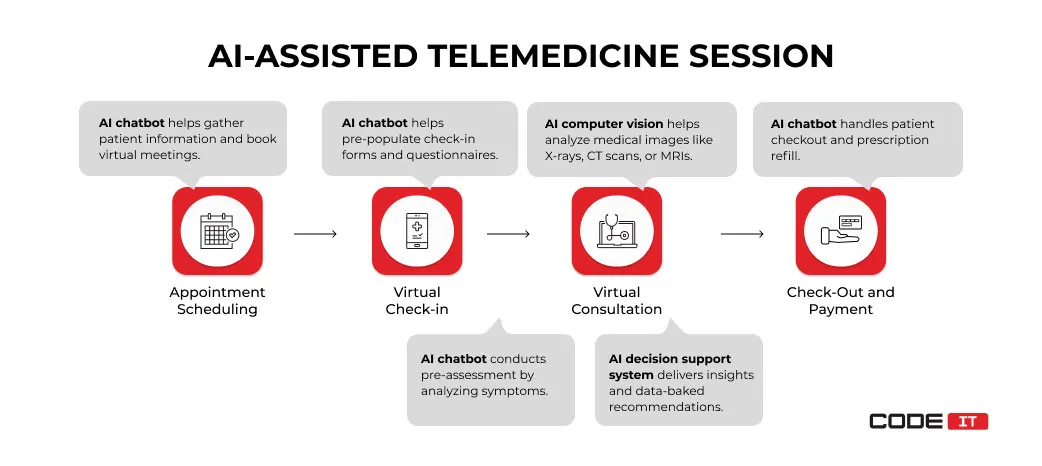
The five most popular AI-powered telehealth solutions that help doctors, nurses, and patients are the following.
1. AI Chatbots
Smart chatbots widely represent the usage of artificial intelligence in telehealth. Being powered by large language models (LLMs) and trained on large datasets, they can:
- processes natural language
- provide answers
- automate tasks (if integrated with third-party systems)
- translate in live time
- collect and analyze data
2. Computer Vision
Computer vision is one of the AI-driven telehealth advancements. AI algorithms can analyze medical images and spot the signs of illness thanks to the technology’s capability to identify repeating patterns.
The technology improves clinical reasoning by highlighting areas in medical images that need to be thoroughly examined by a doctor. The AI computer vision technology can analyze a large assortment of medical images, including:
- Photos
- X-ray scans
- CT scans
- MRIs
- Ultrasound images
3. Decision Support System
Decision support systems keep enhancing telemedicine with artificial intelligence. In a nutshell, the solution is software that helps doctors make decisions by providing data-backed reasoning.
The software may be integrated with external systems to analyze a patient’s medical history or monitor data in live data. Using a clinical decision support system, doctors can:
- aggregate medical data from multiple sources
- receive data-baked recommendations
- stay aligned with clinical protocols
- check risk-assessment reports
- stay alerted about emergencies
4. Remote Patient Monitoring
The healthcare solution describes the usage of wearables for interrupted medical indicators monitoring. Wearable devices can collect and transfer medical data to a healthcare provider automatically.
AI-driven systems analyze the data in real time. If severe changes or emergencies are detected, a doctor gets notified simultaneously. The types of data that wearables can collect include:
- physical activity and sleep
- heart rate
- blood pressure
- oxygen level in the blood
- body temperature
5. Predictive Analytics
AI algorithms can analyze large amounts of patient data to identify patterns and trends. Being trained on large datasets of medical data, an AI-powered predictive analytics solution can help:
- identify the risks of illness development
- detect signs of disease progression
- find possible illness readmission signs
Access the industry expertise to develop an AI telemedicine app

Business First
Code Next
Let’s talk
Telemedicine vs On-site Consultation
The telehealth approach is gaining popularity because it helps patients save time by eliminating the need to travel to a clinic and waiting time.
Telehealth sessions can be run over the following:
- text chat
- phone
- video conference
Usually, telehealth sessions are performed using desktop or mobile devices equipped with front-facing cameras. Hence, doctors can conduct visual assessments and maintain a human touch during conversations.
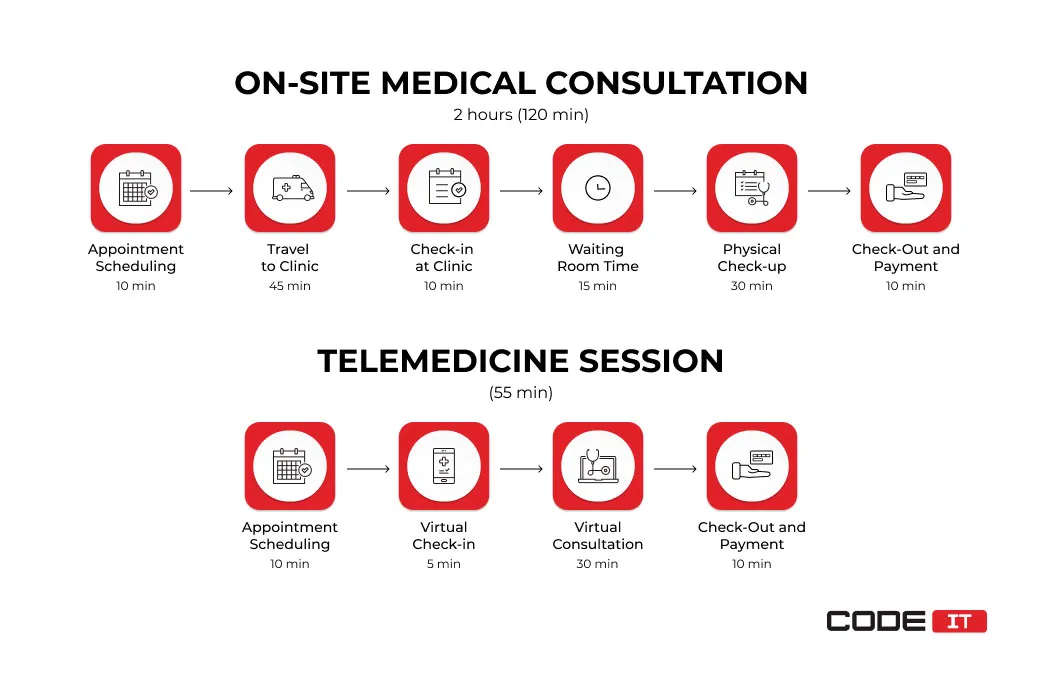
The main advantages of telehealth sessions over on-site clinic consultations include the following.
- Increased patient satisfaction. Telemedicine helps reduce travel and waiting time, which results in increased patient satisfaction.
- Better health care accessibility. Patients from remote areas can access healthcare consultation services, especially when urgent assistance is needed in a hard-to-reach location.
- Reduced infection spread. Patients don’t need to travel to an on-site clinic, significantly reducing the risk of spreading viruses because of the absence of physical contact with other people.
- Ongoing health conditions monitoring. Health monitoring devices can consistently collect patients’ health metrics and transfer them to doctors.
- Ongoing health conditions monitoring. Patients can consult with more medical specialists outside their local area with telemedicine.
The benefits of telehealth can be further expanded with the implementation of artificial intelligence. Find out how telemedicine and AI integration are perfectly bound together and help improve patient care.
The Synergy Of AI And Telemedicine
Artificial intelligence in telehealth is a supplement that helps improve many processes in healthcare workflows. These days, AI and telemedicine are bound together, delivering outstanding medical experience and data-baked reasoning.
Let’s explore the synergy of telemedicine and AI. Check out an AI-assisted medical screening workflow, compared to a typical workflow without AI-driven telehealth advancements.
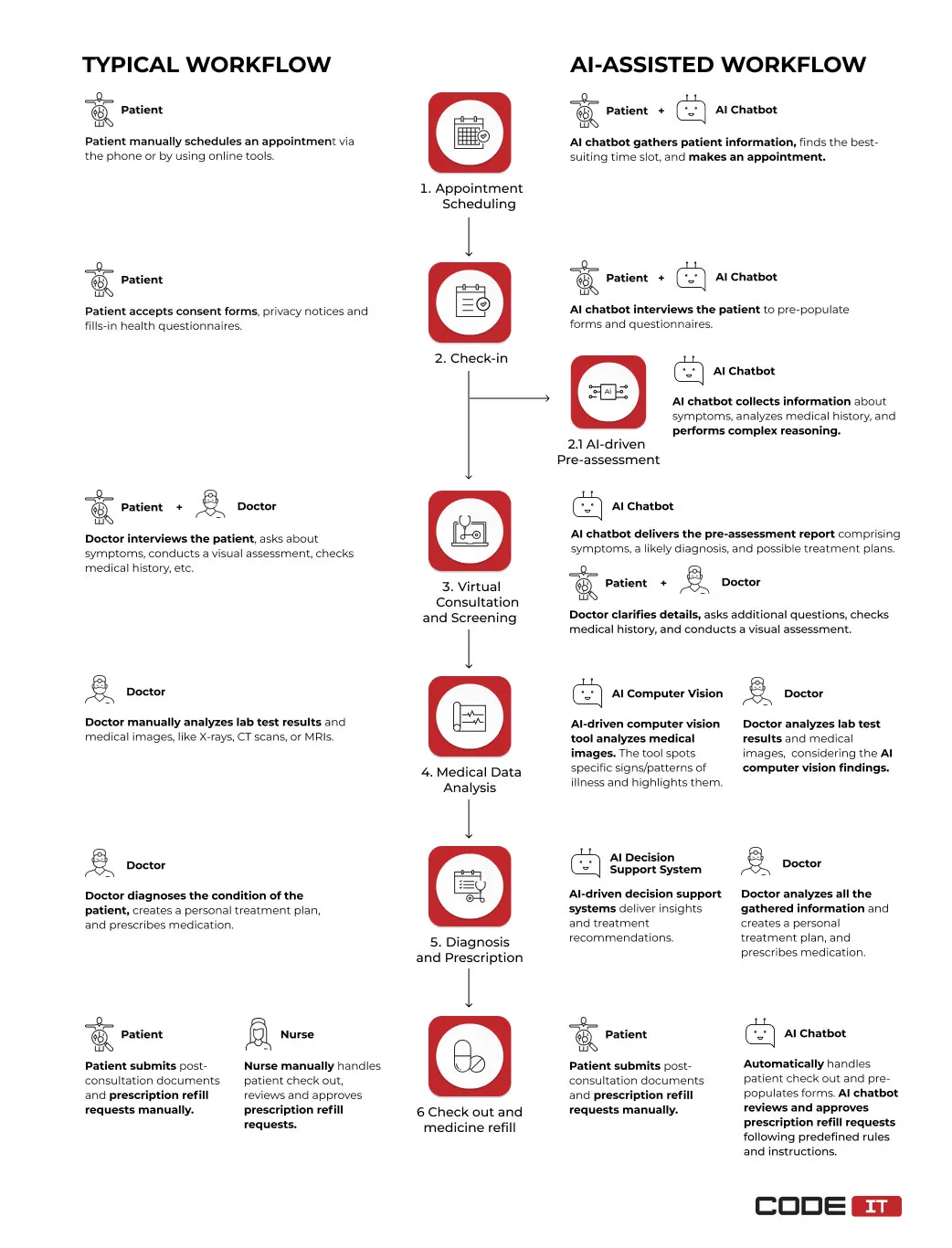
1. Appointment Scheduling + AI Chatbot
AI-driven chatbots can communicate with patients, analyze their needs, and submit appointments on their behalf. Using the technology, a patient can pick the best-suiting time slot and the most qualified doctor and ask a chatbot to book a meeting.
Besides, AI telemedicine bots can send reminders to keep patients updated about upcoming telehealth meetings.
2. Check-in + AI Chatbot
AI chatbots help patients check in without involving a clinic’s staff. Being connected to third-party medical billing and coding software, they can pre-populate forms that patients need to fill out. Also, they can ask and clarify questions to fill in patient questionnaires. Also, LLMs used by AI chatbots can use the knowledge gained through the learning process to answer patients’ questions.
3. Virtual Consultation + AI-Driven Pre-Assessment
In order to enhance the performance of doctors, AI chatbots can conduct pre-assessment by asking questions and suggesting symptoms. Hence, healthcare specialists can save time by getting a detailed pre-assessment report before a consultation begins.
4. Medical Data Analysis + AI Computer Vision
The benefits of AI in telemedicine imply the opportunity to analyze medical images using smart and self-learning algorithms. AI-driven algorithms can analyze a large variety of medical images, highlighting detected patterns or spots that a doctor needs to double-check in more detail.
5. Diagnosis + AI Decision Support System
AI-driven decision support systems (DSSs) provide ongoing support for doctors during consultations. AI systems and deep learning algorithms can analyze symptoms, suggest diagnosis, and create treatment plans. Also, DSSs can analyze patients’ medical history to identify trends or possible risks.
6. Check Out and Prescription Refill + AI Chatbot
AI chatbots can compose documents, including bills, and provide patient payment links. Being integrated with third-party systems, an AI chatbot can automatically process patient prescription refill requests.
Develop an AI-enabled medical solution with CodeIT

Business First
Code Next
Let’s talk
Benefits Of AI In Telemedicine
The combination of AI and telemedicine helps improve the existing workflows and enhance the accuracy of diagnosis. Enhancing telemedicine with artificial intelligence helps achieve the following positive outcomes for healthcare providers.
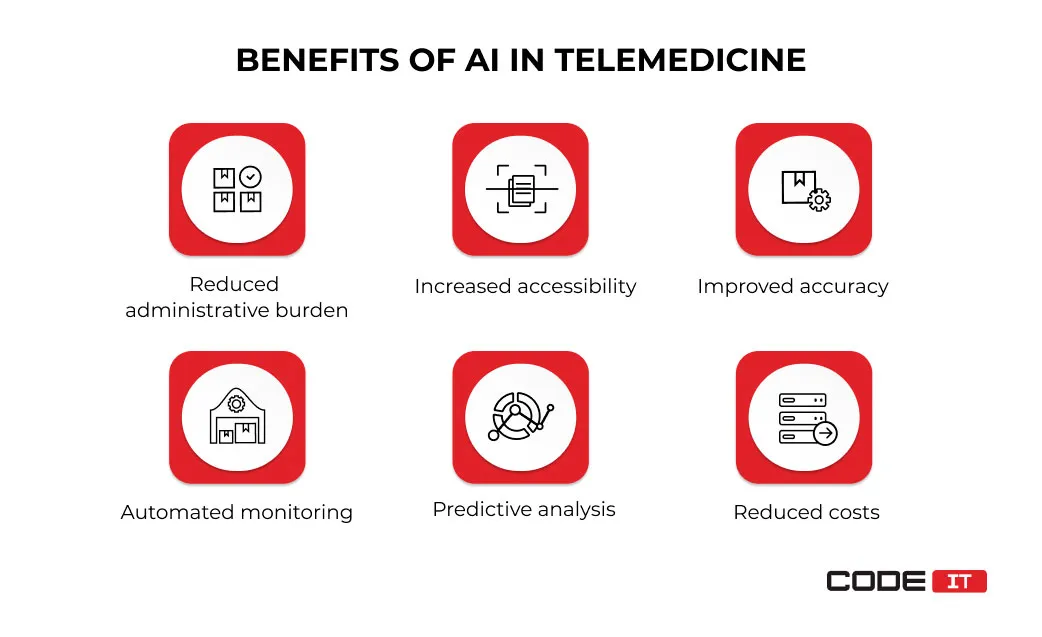
Reduced Administrative Burden
AI telemedicine helps automate bothersome administrative processes. A chatbot can ask questions and clarify data when communicating with patients. Also, they can collect data, conduct reasoning, and automate workflows if connected with third-party software.
The foremost administrative tasks that telemedicine AI chatbots can tackle are:
- provide information upon patients’ requests
- suggest diagnoses by analyzing symptoms
- schedule appointments and send reminders
- pre-populate documents using collected data
Statistics: More than 33% of tedious tasks tackled by nurses can be taken by AI-driven chatbots.
Increased Accessibility
Solutions built by artificial intelligence in telehealth can work 24/7 without interruptions. Also, they can handle multiple conversations and requests simultaneously. AI chatbots can provide personalized medical consultations and mental health support online.
Statistics: AI chatbots can tackle up to 90% of healthcare queries, decreasing the cost of providing services for hospitals.
Improved Accuracy
AI-driven tools like chatbots, decision support systems, or computer vision help doctors improve medical reasoning and diagnosis accuracy. These technologies help identify signs of illness on medical images, suggest diagnoses, or compose treatment plans.
Statistics: Med-PaLM 2, Google’s large language model, has achieved 86.5% accuracy in answering medical questions.
Automated Monitoring
Telehealth artificial intelligence solutions can automatically analyze medical data received from patients. They can pre-process the data and spot possible illness signs, eliminating the need for doctors to monitor patients’ data manually. Besides, AI-driven monitoring systems can alert healthcare providers when they detect severe changes.
Statistics: 9 of 10 surveyed hospitals plan to adopt AI for remote patient monitoring in 2025.
Predictive Analysis
AI-powered telehealth solutions can predict possible health changes or treatment outcomes.
The technology can analyze a patient’s medical history, symptoms, and health data collected by wearables to forecast possible changes in health conditions. Early illness trend change detection helps adjust treatment plans for achieving better outcomes.
Statistics: AI algorithms have achieved 70% accuracy in predicting the risk of heart diseases.
Reduced Costs
The implementation of automation, medical data analysis, and clinical reasoning support helps improve efficiency and cut costs. Doctors and medical staff focus on the most critical tasks. AI-driven solutions like chatbots can tackle cases with lower priority.
Statistics: The automation and process optimization driven by the implication of AI technologies help cut up to 20% of costs in the healthcare industry.
Real-world AI Chatbot Applications
Many healthcare providers have adopted AI-driven technologies to optimize their telemedicine services. Learn more about the top three real-world AI applications in the healthcare industry.
1. Mayo Clinic
Mayo Clinic is one of the pioneers in implementing artificial intelligence in telehealth. The clinic has partnered with Google and implemented the AI chatbot tailored to the healthcare niche. Currently, the healthcare AI chatbot is being tested by the Mayo Clinic.
The chatbot can provide medical consultations. It has shown 86.5% accuracy in answering medical questions. Also, the chatbot can:
- retrieve medical data from different sources
- translate and summarize medical data
- identify diagnoses by analyzing symptoms and medical history
- develop treatment plans
2. Cleveland Clinic
Cleveland Clinic is actively adopting telemedicine AI solutions to improve patient care. The AI-driven chatbot used by the clinic is designed to assist patients with different queries, including:
- symptoms check and illnesses suggesting
- appointments scheduling
- reminders and follow-up
- treatment recommendation
- patient guidance and specialist suggestions
3. Stanford Health Care
The Stanford Medical Center uses AI to empower most healthcare operations and improve. The technology helps speed up processes and improve the accuracy of analysis. The chatbot used by the healthcare provider is capable of:
- asking questions and retrieving medical data
- answering questions and providing recommendations
- analyzing symptoms and conducting medical reasoning
- appointment scheduling and reminders creation
- managing insurance and billing queries
Besides, Stanford Health Care uses AI to analyze medical images. The usage of AI in telemedicine helps the company identify the risks of heart stroke, skin cancer, or irreversible eyesight health changes at early stages.
Need to create a tailor-made AI chatbot for your clinic?

Business First
Code Next
Let’s talk
Codeit AI Transformation Expertise
Our AI Lab has released dozens of applications that enable automation with Artificial Intelligence.
Learn more about an advanced tool for pharmacological research built by software engineers.
Problem
The client needed a secure yet effective tool for processing large amounts of clinical research data. Also, the client aimed to streamline compliance management and automate bothersome workflows with AI.
Solution
The CodeIT team has developed an AI-driven software that enables researchers to fast and securely explore extensive databases of medical data. Being integrated with the internal systems, the tool enabled the following:
- Smart search and data retrieval
- Custom instructions and context-aware answers
- Automate manual workflows
- Securely transfer company data within on-site system
- Ensure regulatory compliance adherence
Security Tips From Codeit AI Lab
It’s crucial to ensure top-tier security for digital solutions in the healthcare industry. The following tops will help you build secure AI-driven solutions, minimizing the risk of data breaches.
- Self-hosted architecture—Deploy AI-applications on on-premise servers so that no data is shared with external vendors.
- Open-source technologies—Avoid the vendor lock-in by using open-source code, having the opportunity to adjust, scale, and upgrade your software in the future.
- Role-based access control (RBAC)—Ensure only authorized users can access sensitive information, based on their roles and permissions.
- Real-time logging & monitoring—Track all the actions to rapidly identify and track security issues.
- Secure API gateways—Enable secured AI model interactions with OAuth 2.0 authentication and rate limiting.
- Data masking & anonymization—Protect sensitive data like patient records by enabling automated anonymization.
- Regular security audits—Run scheduled assessments to identify possible vulnerabilities and security issues in the early stages.
- Multi-factor authentication (MFA)—Implement additional security measures to prevent unauthorized access.
Challenges Of Combining Telemedicine And AI
The implication of artificial intelligence in telehealth is related to major challenges. The four core obstacles that early adopters need to overcome are as follows.
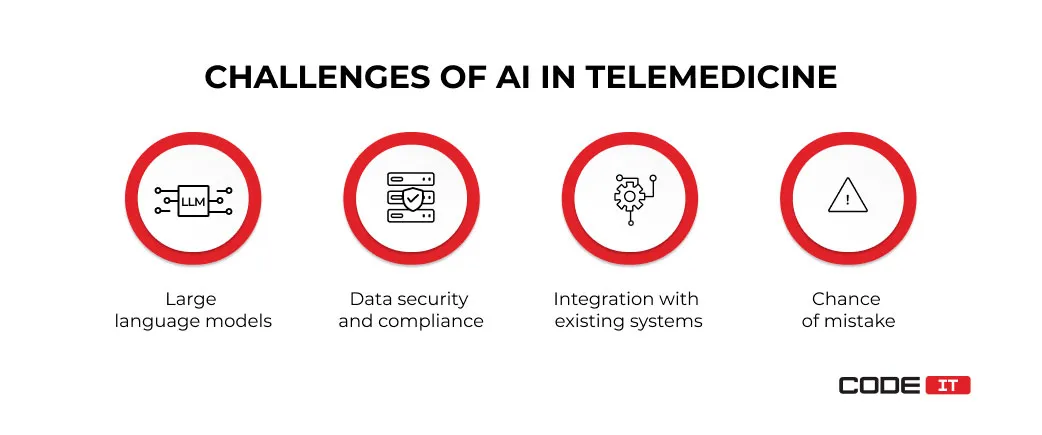
1. Large Language Model Integration or Creation
An LLM is the core part of an AI chatbot. It analyzes queries, understands the intent, and generates answers.
LLM integration
The top LLMs available for commercial usage are:
- ChatGPT 4
- ChatGPT 3.5
- PaLM 2 (Google BARD)
- Falcon 40
These models were trained on large datasets from different domains. Hence, these models may not be effective at conducting medical reasoning.
Med-PaLM 2 is an innovative LLM that was trained on medical data. It can answer medical questions with 85%+ accuracy. However, the model isn’t available yet for commercial usage.
LLM creation
The creation of a new large language model tailored to facilitating doctors and consulting patients is a complicated process. The main steps of developing a custom LLM are:
- Data collection and preparation
- LLM architecture development
- Model training
- Model evaluation and tuning
The success of LLM development heavily depends on the quality and quantity of data used for training. Also, the process requires large infrastructure investments to cover all the computing power demand.
2. Data Security and Compliance
The healthcare industry is highly regulated, especially in the US. Healthcare providers are obliged to develop security measures that ensure that sensitive data can be safely transferred over the Internet. Also, they need to comply with medical regulations, including HIPAA, CCPA, and HITECH.
When integrating a third-party LLM, it’s crucial to consider whether the model uses the information patients input for further training. If so, it can lead to the potential exposition of sensitive data submitted by patients.
3. Integration with Existing Systems
The medical industry heavily relies on standardization and medical data interoperability. It helps transfer medical data over different systems error-free. Hence, additional medical data validation, interpretation, or coding tools may need to be deployed to connect telemedicine AI applications with third-party tools.
Also, it may be required to establish secure user authentication and authorization mechanisms to automate administrative operations.
4. Chance of Mistake
AI-driven chatbots tend to deliver inaccurate responses or incorrectly identify diagnoses. The biases or inaccuracies can be caused by the poor data quality used for training or insufficient LLM testing and tuning.
As a result, 60% of Americans don’t want their healthcare providers to rely solely on AI when providing healthcare services. Moreover, 88% of monitored AI chatbot interactions required real doctor assistance. Only 12% of patients have reported a successful interaction with an AI chatbot without further relocation to a human operator.
AI In Telemedicine — Future Prospects
The generative AI breakthrough has begun and is expected to rise at a high pace, shaping the future of the healthcare industry. Let’s check the future prospects of the implication of artificial intelligence in telehealth.
As per the research conducted by Accenture, 70% of tasks taken by healthcare professionals can be automated or optimized. It leaves large room for the implementation of AI-driven telehealth advancements.
- 76% of US patients feel comfortable about telemedicine consultations with doctors.
- 70% of healthcare professionals expect to have adopted AI-driven tools to optimize their workflows.
- 86% of physicians believe that AI will heavily affect medical reasoning in the future.
- 20% is the expected increase in healthcare services accessibility with the help of AI telemedicine.
- 54% of surveyed doctors believe that AI adoption makes healthcare services more personalized.
- 75% of healthcare providers plan to increase their spending on implementing AI in telemedicine.
Conclusion
Artificial intelligence in telehealth helps automate processes, optimize reasoning, and improve accuracy. The top AI-driven solutions are:
- AI chatbots
- Computer vision
- Decision support systems
- Remote patient monitoring
- Predictive analytics
Artificial intelligence helps optimize the existing workflows—not to substitute them.
- 60% of patients in the US feel uncomfortable with doctors relying on AI algorithms only when conducting medical reasoning.
- Only 12% of monitored medical AI chatbot interactions have been successfully completed without the assistance of a real healthcare professional.
FAQ
The combination of AI and telemedicine unlocks the opportunity to optimize the existing processes and automate administrative burdens. AI-driven tools can effectively answer questions, identify trends, and detect patterns.
Artificial intelligence helps improve the accessibility of healthcare services. AI-enabled chatbots work 24/7 and can handle multiple independent sessions simultaneously. Also, the technology supports medical reasoning and provides suggestions.
The foremost applications of artificial intelligence in telehealth are:
- AI chatbot: patient consultation and triage, appointment scheduling, check out, prescription refill requests handling.
- Computer vision: medical images analysis.
- Decision support system: symptoms and medical history analysis, treatment plan development.
The usage of telemedicine AI is related to the following risks:
- Inaccurate responses and predictions
- LLM biases
- Possible data security breaches
Yes, AI-driven telehealth advancements help doctors improve the accuracy of medical reasoning in various ways, including:
- Real-time suggestions based on patient data
- Signs of illness detection on medical images
- Predictive analytics reports based on medical history
Telemedicine technology with AI is growing at a high pace. Research estimates that 7 out of 10 tasks tackled by healthcare professionals can be automated or improved with AI.
The top three statistics that define future prospects of using AI in telemedicine are:
- 75% of clinics plan to increase their spending on AI adoption
- 86% of doctors state that AI-driven tools help optimize processes
- 76% of patients feel comfortable visiting doctors virtually
Build your ideal
software today






